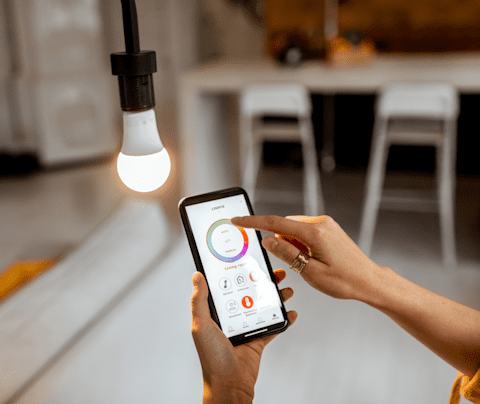Smart Light Bulbs - GeoArm Security®
Free for orders $200 & above!
Lighting Integration!
for Illuminated Automation!
Smart light bulbs are an innovative addition to modern homes, offering both convenience and enhanced security features. These bulbs are designed to be integrated into a smart home ecosystem, allowing users to control them remotely via a smartphone app or through voice commands using a smart home assistant device like Amazon Alexa or Google Assistant. One of the key technologies that enable this integration is the Z-Wave network, a wireless communication protocol that connects smart devices within a home. By using Z-Wave, smart light bulbs can seamlessly communicate with other compatible devices, including security systems, to provide a cohesive and automated home environment.
When connected to a security system, smart light bulbs can significantly enhance the safety of your home. They can be programmed to follow a schedule, turning on and off at specific times to create the illusion of occupancy, which can deter potential intruders. Additionally, these bulbs can be set to activate in response to security events, such as when a motion sensor is triggered or a door is opened. This feature not only helps to illuminate the area for security cameras but also alerts homeowners to potential security breaches.
Beyond security, smart light bulbs offer a range of features that can improve the overall ambiance and functionality of your home. With dimming capabilities, you can adjust the brightness to suit different activities or moods. For instance, you can create a cozy atmosphere by dimming the lights for a movie night or set them to gradually brighten in the morning to simulate a natural sunrise, making waking up more pleasant. Furthermore, smart bulbs can be used to create customized lighting scenes, allowing you to tailor the lighting to your preferences and enhance your living space's aesthetic appeal.

Common Uses of Smart Light Bulbs?
1. Remote Control and Automation - Smart light bulbs can be controlled remotely via smartphone apps, allowing users to turn lights on or off from anywhere. This feature is particularly useful for ensuring lights are off when not needed or for turning them on before arriving home. Additionally, they can be integrated into home automation systems to create schedules or routines, such as turning on lights at sunset or when motion is detected.
2. Energy Efficiency - Many smart bulbs are LED-based, which are more energy-efficient than traditional incandescent bulbs. Users can monitor energy usage through apps, helping to reduce electricity bills by optimizing lighting schedules and usage.
3. Customizable Lighting - Smart bulbs often offer a wide range of color and brightness settings, allowing users to customize the ambiance of a room. This can be used to create different moods for various activities, such as a warm, dim light for relaxation or bright, cool light for working or studying.
4. Voice Control - When integrated with voice assistants like Amazon Alexa, Google Assistant, or Apple HomeKit, smart light bulbs can be controlled using voice commands. This adds an extra layer of convenience, especially when hands-free operation is needed.
5. Security and Safety - Smart bulbs can be used as part of a home security system. For example, they can be programmed to simulate occupancy by turning on and off at random intervals when the homeowner is away, deterring potential intruders. They can also be set to turn on automatically in response to security system alerts.
6. Integration with Other Smart Devices - Smart light bulbs can be integrated with other smart home devices, such as smart doorbells, cameras, or thermostats, to create a cohesive and responsive home environment. For instance, lights can be set to flash when a smart doorbell is pressed or to change color based on the weather forecast.
Installation Tips of Smart Light Bulbs?
1. Check Compatibility - Before purchasing, ensure that the smart light bulbs are compatible with your existing smart home system or hub, such as Z-Wave, Zigbee, or Wi-Fi. Also, verify that they fit the light fixtures you intend to use them in.
2. Install the App - Download the manufacturer's app on your smartphone or tablet. This app will guide you through the setup process and allow you to control the bulbs remotely.
3. Turn Off Power - For safety, always turn off the power to the light fixture at the circuit breaker before installing or replacing any light bulb.
4. Install the Bulb - Screw the smart bulb into the light fixture just like a regular bulb. Ensure it is securely in place.
5. Power On - Turn the power back on at the circuit breaker and switch on the light fixture.
6. Connect to Network - Open the app and follow the instructions to connect the bulb to your Z-Wave compatible smart security system panel. This often involves putting the bulb into pairing mode, which may require turning the light on and off in a specific sequence.
7. Name and Organize - Once connected, name your bulbs in the app for easy identification. You can organize them by room or function for more convenient control.
8. Set Up Automations - Use the app to set up schedules, scenes, or automations. For example, you can program the lights to turn on at sunset or when you arrive home.
9. Update Firmware - Check for any firmware updates for your smart bulbs through the app. Keeping the firmware up to date ensures you have the latest features and security improvements.
10. Test and Adjust - Test the bulbs to ensure they respond correctly to commands. Adjust brightness, color, or other settings to your preference.







